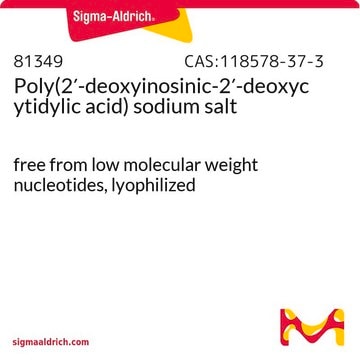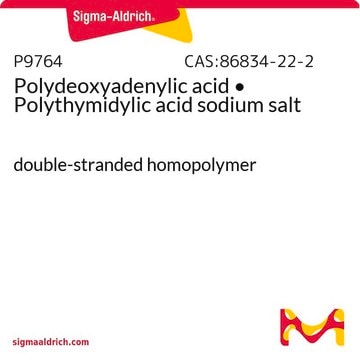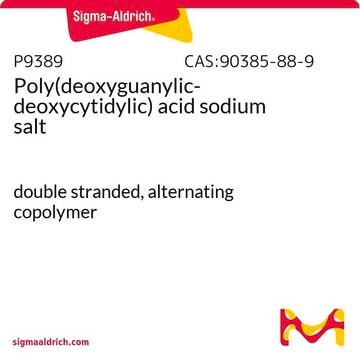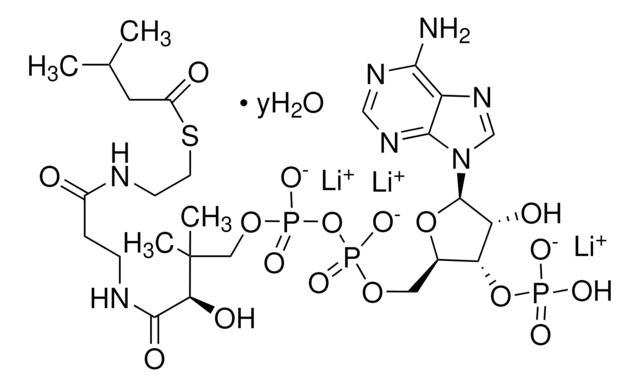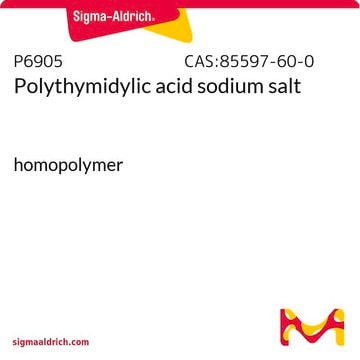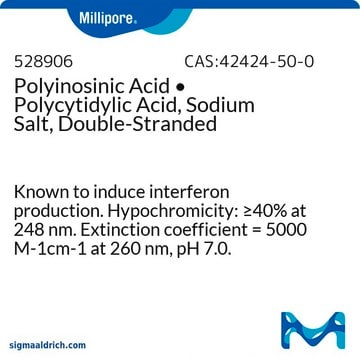The polymer size of this material varies from lot to lot. The typical low range is 150 to 550 base pairs and the typical high range is 3000 to 5000 base pairs. The bulk of the product ranges from 1200 to 3000 base pairs. The molecular weight of a single Poly(dI-dC) base pair is 639.41 g/mol, resulting in an approximate molecular weight range of 767.2 kDa – 1,918.2 kDa for most of the compound. The unit per milligram value may range from 8 – 14 units per milligram and the vial content may range from 5.0 – 7.5 units. The specific vial content is lot specific and may range from 535 – 625 ug per vial. To prepare a 1 ug/ul solution, please see the link below to review the lot specific Certificate of Analysis:
https://www.sigmaaldrich.com/product/sigma/p4929#product-documentation
P4929
Poly(deoxyinosinic-deoxycytidylic) acid sodium salt
double-stranded alternating copolymer
Synonyme(s) :
Poly(dI-dC) • Poly(dI-dC) sodium salt
Sélectionner une taille de conditionnement
Sélectionner une taille de conditionnement
About This Item
Produits recommandés
Vous recherchez des produits similaires ? Visite Guide de comparaison des produits
Application
Actions biochimiques/physiologiques
Autres remarques
Définition de l'unité
Code de la classe de stockage
11 - Combustible Solids
Classe de danger pour l'eau (WGK)
WGK 3
Point d'éclair (°F)
Not applicable
Point d'éclair (°C)
Not applicable
Équipement de protection individuelle
Eyeshields, Gloves, type N95 (US)
Faites votre choix parmi les versions les plus récentes :
Certificats d'analyse (COA)
Vous ne trouvez pas la bonne version ?
Si vous avez besoin d'une version particulière, vous pouvez rechercher un certificat spécifique par le numéro de lot.
Déjà en possession de ce produit ?
Retrouvez la documentation relative aux produits que vous avez récemment achetés dans la Bibliothèque de documents.
Les clients ont également consulté
-
How to prepare the product of P4929-5U to 1ug/ul? What's the weight (mg), and molecular weight (g/mol) of this product?
1 réponse-
Utile ?
-
-
Should I heat the product P4929-25U after resuspension to make aliquots? If yes, then how long and at what temperature? Thank you!
1 réponse-
This product is soluble in water or neutral buffer. Solubility is no longer considered part of the specifications, but it was previously reported to be soluble at 20 mg/mL in 0.1 M Tris-HCl, pH 8.8. Heat is not necessary to solubilize the product; dissolving in an appropriate solvent is the recommended method for resuspension.
Utile ?
-
-
What is the Department of Transportation shipping information for this product?
1 réponse-
Transportation information can be found in Section 14 of the product's (M)SDS.To access the shipping information for this material, use the link on the product detail page for the product.
Utile ?
-
-
Is Is Product P4929, Poly(deoxyinosinic-deoxycytidylic) acid sodium salt (Poly(dI-dC), stable in solution?
1 réponse-
Both the solution and solid are very stable and can be stored for extended periods (years) at -20 °C.
Utile ?
-
-
How many milligrams of Product P4929, Poly(deoxyinosinic-deoxycytidylic) acid sodium salt, do I have?
1 réponse-
The specifications for the product is approximately 13 U/mg, but the exact amount is lot specific. One unit will yield an A260 of 1.0 in 1.0ml of water. For example, the 5 unit size has approximately 0.384 mg.
Utile ?
-
-
What is the molecular weight of Product P4929, Poly(deoxyinosinic-deoxycytidylic) acid sodium salt?
1 réponse-
Molecular weight: Polymer size (by agarose gel electrophoresis) is lot dependent with a lower range of less than 150 to 550 base pairs and a high range of 3000 to over 5000 base pairs. Most of the material is between 1200 to 3000 base pairs.
Utile ?
-
-
What is the solubility of Is Product P4929, Poly(deoxyinosinic-deoxycytidylic) acid sodium salt (Poly(dI-dC)?
1 réponse-
This product is soluble in water or neutral buffer at 20 mg/ml.
Utile ?
-
Filtres actifs
Notre équipe de scientifiques dispose d'une expérience dans tous les secteurs de la recherche, notamment en sciences de la vie, science des matériaux, synthèse chimique, chromatographie, analyse et dans de nombreux autres domaines..
Contacter notre Service technique
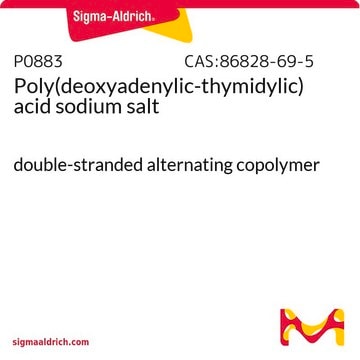
![Poly[d(I-C)] lyophilized, pkg of 10 U (10108812001 [A<sub>260</sub> units]), pkg of 50 U (11219847001 [A<sub>260</sub> units])](/deepweb/assets/sigmaaldrich/product/images/352/091/ef743cea-ccd8-44f1-8f3b-dec5a1e4f5d1/640/ef743cea-ccd8-44f1-8f3b-dec5a1e4f5d1.jpg)
